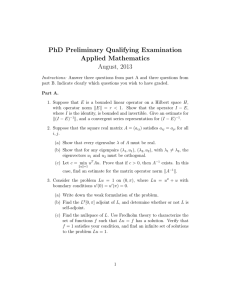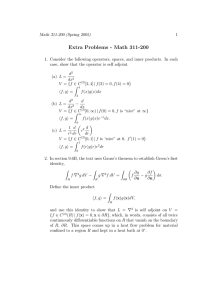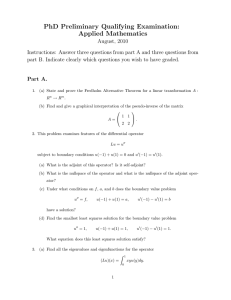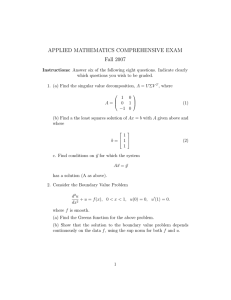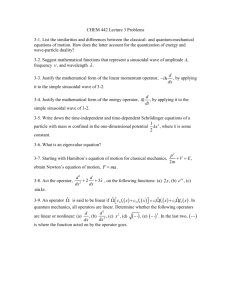Chapter 4 Adjoint-state methods
advertisement
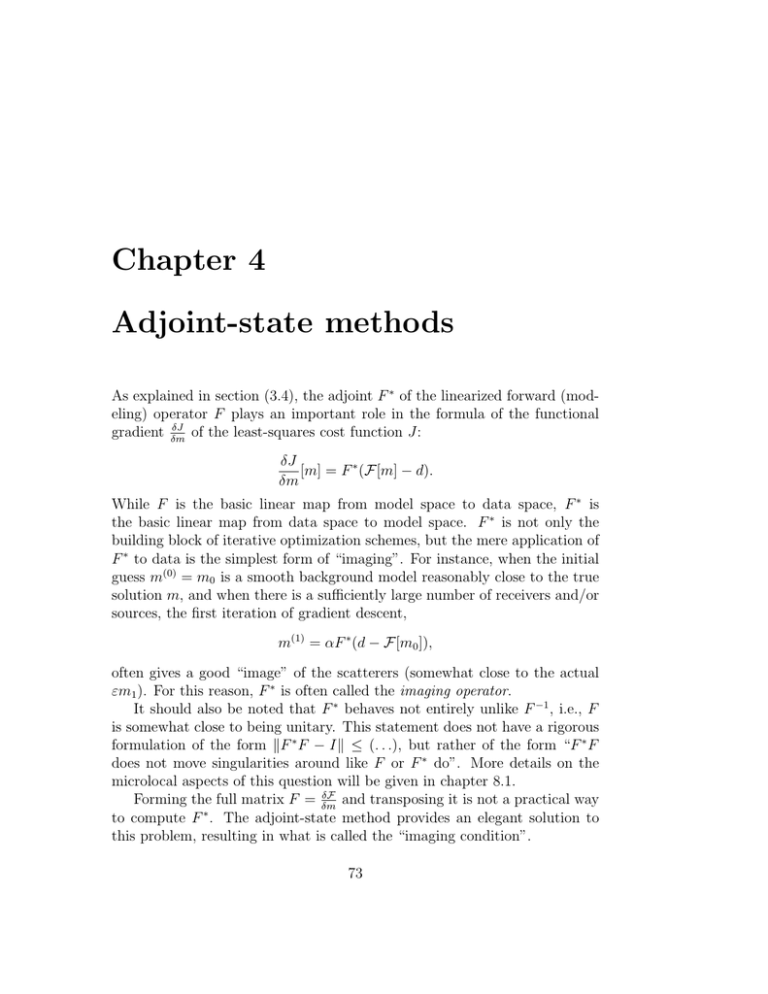
Chapter 4
Adjoint-state methods
As explained in section (3.4), the adjoint F ∗ of the linearized forward (modeling) operator F plays an important role in the formula of the functional
δJ
of the least-squares cost function J:
gradient δm
δJ
[m] = F ∗ (F[m] − d).
δm
While F is the basic linear map from model space to data space, F ∗ is
the basic linear map from data space to model space. F ∗ is not only the
building block of iterative optimization schemes, but the mere application of
F ∗ to data is the simplest form of “imaging”. For instance, when the initial
guess m(0) = m0 is a smooth background model reasonably close to the true
solution m, and when there is a sufficiently large number of receivers and/or
sources, the first iteration of gradient descent,
m(1) = αF ∗ (d − F[m0 ]),
often gives a good “image” of the scatterers (somewhat close to the actual
εm1 ). For this reason, F ∗ is often called the imaging operator.
It should also be noted that F ∗ behaves not entirely unlike F −1 , i.e., F
is somewhat close to being unitary. This statement does not have a rigorous
formulation of the form kF ∗ F − Ik ≤ (. . .), but rather of the form “F ∗ F
does not move singularities around like F or F ∗ do”. More details on the
microlocal aspects of this question will be given in chapter 8.1.
δF
and transposing it is not a practical way
Forming the full matrix F = δm
∗
to compute F . The adjoint-state method provides an elegant solution to
this problem, resulting in what is called the “imaging condition”.
73
74
4.1
CHAPTER 4. ADJOINT-STATE METHODS
The imaging condition
For any dr (t) function of the receiver index r and time t, and m(x) function
of position x (here m and d are two arbitrary functions, not necessarily linked
to one another by the forward model), we have
hd, F mi = hF ∗ d, mi.
The inner product on the left is in data space,
Xˆ T
dr (t)u(xr , t) dt,
hd, F mi =
r
u = F m,
0
while the inner product on the right is in model space.
ˆ
∗
hF d, mi =
(F ∗ d)(x)m(x) dx.
Rn
The relation u = F m is implicitly encoded by the two equations
∂2
∂ 2 u0
m0 2 − ∆ u = −m 2 ,
∂t
∂t
∂2
m0 2 − ∆ u0 = f.
∂t
Note that a single right-hand side generates u0 , and that we have omitted the
source subscript s in this section; we will return to multiples sources shortly.
´ T argument that isolates and makes explicit the contribution of m in
P The
r 0 dr (t)u(xr , t) dt is one of integration by parts. In order to integrate by
parts in x, we need to turn the sum over receivers into an integral. This
can be achieved by considering a distributional extended dataset where each
measurement dr (t) is accompanied by a Dirac delta located at xr :
X
dext (x, t) =
dr (t)δ(x − xr ).
r
We then have
ˆ
ˆ
hd, F mi =
T
dext (x, t)u(x, t) dxdt.
Rn
0
In
to use the wave equation for u, a copy of the differential operator
order
∂2
m0 ∂t2 − ∆ needs to materialize. This is done by considering an auxiliary
4.1. THE IMAGING CONDITION
75
field q(x, t) that solves the same wave equation with dext (x, t) as a right-hand
side:
∂2
x ∈ Rn ,
(4.1)
m0 2 − ∆ q(x, t) = dext (x, t),
∂t
with as-yet unspecified “boundary conditions” in time. Substituting this
expression for dext (x, t), and integrating by parts both in space and in time
reveals
ˆ ˆ T
∂2
hd, F mi =
q(x, t) m0 2 − ∆ u(x, t) dxdt
∂t
V 0
ˆ
ˆ
∂q
∂u
m0 u|T0 dx −
m0 q |T0 dx
+
∂t
∂t
V
V
ˆ ˆ T
ˆ ˆ T
∂u
∂q
u dSx dt −
q
+
dSx dt,
∂n
∂V 0
∂V 0 ∂n
where V is a volume that extends to the whole of Rn , and ∂V is the boundary
of V — the equality then holds in the limit of V = Rn .
The boundary terms over ∂V vanish in the limit of large V by virtue
of the fact that they involve u – a wavefield created by localized functions
f, m, u0 and which does not have time to travel arbitrarily far within a time
| = 0. As for
[0, T ]. The boundary terms at t = 0 vanish due to u|t=0 = ∂u
∂t t=0
the boundary terms at t = T , they only vanish if we impose
q|t=T =
∂q
|t=T = 0.
∂t
(4.2)
Since we are only interested in the values of q(x, t) for 0 ≤ t ≤ T , the
above are final conditions rather than initial conditions, and the equation
(4.1) is run backward in time. The wavefield q is called adjoint field, or
adjoint state. The equation (4.1) is itself called adjoint equation. Note that
q is not in general the physical field run backward in time (because of the
limited sampling at the receivers), instead, it is introduced purely out of
computational convenience.
The analysis needs to be modified when boundary conditions are present.
Typically, homogeneous Dirichlet and Neumann boundary conditions should
the same for u0 and for q – a choice which will manifestly allow to cancel
out the boundary terms in the reasoning above – but absorbing boundary
conditions involving time derivatives need to be properly time-reversed as
well. A systematic, painless way of solving the adjoint problem is to follow
76
CHAPTER 4. ADJOINT-STATE METHODS
the following sequence of three steps: (i) time-reverse the data dext at each
receiver, (ii) solve the wave equation forward in time with this new righthand-side, and (iii) time-reverse the result at each point x.
We can now return to the simplification of the left-hand-side,
ˆ
ˆ
T
∂2
q(x, t) m0 2 − ∆ u(x, t) dxdt
hd, F mi =
∂t
Rn 0
ˆ ˆ T
∂ 2 u0
q(x, t)m(x) 2 dxdt
=−
∂t
Rn 0
This quantity is also supposed to be hm, F ∗ di, regardless of m, so we conclude
ˆ
∗
(F d)(x) = −
T
q(x, t)
0
∂ 2 u0
dt.
∂t2
(4.3)
This equation is called the imaging condition: it expresses the action of F ∗
on d as the succession of the following steps:
1. Place data dr (t) at the location of the receivers with point masses to
get dext ;
2. Use dext as the right-hand side in the adjoint wave equation to get the
adjoint, backward field q;
3. Simulate the incident, forward field u0 ; and finally
4. Take the time integral of the product of the forward field u0 (differentiated twice in t), and the backward field q, for each x independently.
The result is a function of x which sometimes serves the purpose of image,
and may sometimes be called Im (x). Note that we have not performed a
full inversion; if d are measured data, then Im is not the model m that gave
rise to d. In seismology, the imaging condition (4.3) is called reverse-time
migration, or simply migration. In radar, the imaging condition does not have
a particular name, but in the next chapter we will encounter a simplification
of (4.3) called backprojection.
If we now restore the presence of multiple sources, the wavefields u, u0 ,
and u1 will depend on the source index s. The source term fs — typically of
the form w(t)δ(x − xs ) — is in the right-hand side of the wave equations for
4.1. THE IMAGING CONDITION
77
u0 and u, while u1 implicitly depends on fs through u0 . For a fixed source
s, we denote
us = Fs [m],
u0,s = Fs [m0 ],
u1,s = Fs m1 ,
while we continue to denote u = F[m], u0 = F[m0 ] and u1 = F m1 for the
collection of such wavefields over s.
The data inner-product now has an additional sum over s, namely
XXˆ T
hd, F mi =
dr,s (t)us (xr , t) dt.
s
r
0
The formula for F ∗ can be obtained by taking adjoints one s at a time,
namely
X
hF ∗ d, mi = hd, F mi =
hds , Fs mi
s
=
X
hFs∗ ds , mi
s
X
=h
Fs∗ ds , mi,
s
hence
F∗ =
X
Fs∗ .
s
More explicitly, in terms of the imaging condition,
Xˆ T
∂ 2 u0,s
∗
(x, t) dt,
(F d)(x) = −
qs (x, t)
∂t2
0
s
(4.4)
where the adjoint field qs is relative to the source s:
∂2
m0 2 − ∆ qs (x, t) = dext,s (x, t).
∂t
The sum over s in the new imaging condition (4.4) is sometimes called a stack.
It is often the case that particular images Fs∗ d are not very informative on
their own, but a stack uses the redundancy in the data to bring out the
information and reveal more details.
The mathematical tidbit underlying stacks is that the operation of creating a vector (x, x, . . . , x) out of a single number x has for adjoint the operation
of summing the components of a vector.
78
4.2
CHAPTER 4. ADJOINT-STATE METHODS
The imaging condition in the frequency
domain
We now modify the exposition to express both the adjoint-state equation
and the imaging condition in the frequency (ω) domain. The nugget in this
section is that complex conjugation in ω corresponds to time reversal. We
assume a single source for simplicity.
We are again interested in finding F ∗ such that hd, F mi = hF ∗ d, mi for
all generic d and m. The data inner product hd, F mi can be expressed in the
frequency domain by means of the Parseval formula,
Xˆ
Xˆ
\
b
dr (t)(F m)(xr , t)dt.
hd, F mi = 2π
dr (ω)(F m)(xr , ω)dω =
r
R
r
The complex conjugate is important, now that we are in the frequency domain – though since the overall quantity is real, it does not matter which
of the two integrand’s factors it is placed on. As previously, we pass to the
extended dataset
X
dd
dbr (ω)δ(x − xr ),
ext (x, ω) =
r
and turn the sum over r into an integral over x. The linearized scattered
field is
ˆ
\
b(x, y; ω)m(y)ω 2 ub0 (y, ω) dy.
(F m)(xr , ω) = G
(4.5)
To simplify the resulting expression of hd, F mi, we let
ˆ
b(y, x; ω)dd
qb(x, ω) = G
ext (y, ω) dy.
(4.6)
(Note that Green’s functions are always symmetric under the swap of x and
y, as we saw in a special case in one of the exercises in chapter 1.) It follows
that
ˆ
ˆ
hd, F mi =
m(y) 2π
R
qb(y, ω)ω 2 ub0 (y, ω) dω dy,
ˆ
hence
∗
F d(y) = 2π
R
qb(y, ω)ω 2 ub0 (y, ω) dω.
(4.7)
4.3. THE GENERAL ADJOINT-STATE METHOD
79
This equation is the same as (4.3), by Parseval’s identity. Equation (4.6) is
the integral version of (4.1) in the frequency domain. The complex conjub in (4.6) is the expression in the frequency domain of the fact
gation of G
that the adjoint equation is solved backwards in time1 . We can alternatively
bd
bdd
interpret qb = G
b = Gd
ext , which
ext by applying an extra conjugate, namely q
can be read as the sequence of operations: (i) time-reverse dext , (ii) propagate it forward in time, and (iii) time-reverse the result. This is the same
prescription as in the time-domain case, and offers the added advantage of
not having to rethink the boundary condition for the backward equation.
The integral in t in (4.3) is over [0, T ] because such is the support of
∂ 2 u0
q ∂t2 . The integral in ω in (4.7) is over R. It is tempting to truncate
this integral to “the frequencies that have been measured” — but that is
strictly speaking incompatible with the limits on t (for the same reason that a
function compactly supported in time cannot also be compactly supported in
frequency.) Careful consideration of cutoffs is needed to control the accuracy
of a truncation in ω.
Equation (4.7) is valuable for a few different reasons:
• It can be further simplified to highlight its geometrical content as an
approximate curvilinear integral, such as explained in the next chapter;
• The integral over ω can be deliberately restricted in the scope of descent
iterations, so as to create sweeps over frequencies. This is sometimes
important to deal with the lack of convexity of full inversion; see chapter
9.
4.3
The general adjoint-state method
In this section we explain how to use the adjoint-state method to compute the
first and second variations of an objective function J[u(m)] in a parameter
m, when u is constrained by the equation L(m)u = f , where L(m) is a linear
operator that depends on m.
1
Time reversal of any real-valued function becomes conjugation in the Fourier domain:
ˆ
fb(ω) =
ˆ
eiωt f (t) dt =
ˆ
e−iωt f (t)dt =
eiωt f (−t) dt.
80
CHAPTER 4. ADJOINT-STATE METHODS
We refer to “u space”, “m space”, and “f space” for the respective L2
spaces containing u, m, and f . The first variation of J is simply
δJ
δJ δu
=h ,
iu ,
(4.8)
δm
δu δm
where the inner product pairs δu in each equation, hence acts in u space.
Notice that δu/δm is an operator acting in m space and returning a function in
u space2.
If we were interested in computing the directional derivative of J in some
δJ
, mi, then we would simply swap the m-space inner
direction m, namely h δm
product with the u-space inner product from (4.8), and recognize that u =
δu
m is easily accessible by solving the linearized version of the equation
δm
L(m)u = f . This result is straightforward to obtain, and the adjoint-state
method is not necessary.
δJ
as a function in mThe interesting problem is that of computing δm
space. In principle, equation (4.8) is all that is needed for this purpose,
δu
except that explicitly computing the full kernel of the operator δm
can be
highly inefficient in comparison to the complexity of specifying the function
δJ
.
δm
δu
The adjoint-state method is a very good way of eliminating δm
so that
δJ
can be computed in more favorable complexity. In order to achieve this,
δm
differentiate the “state equation” L(m)u = f with respect to m to get
δL
δu
u+L
= 0.
δm
δm
δu
We see that δm
can be eliminated by composition with L on the left. The
main idea of the adjoint-state method is that a copy of L can materialize
in (4.8) provided the other factor, δJ
, is seen as the adjoint of L applied to
δu
some field q,
δJ
,
(adjoint-state equation)
δu
with q naturally called the adjoint field. Then,
L∗ q =
δJ
δu
δu
= hL∗ q,
iu = hq, L
if
δm
δm
δm
δL
= −hq,
uif
(imaging condition)
δm
2
(4.9)
(4.10)
It relates to what we called F = δF/δm earlier by the operator S of sampling at the
receivers, via F = Su or δF/δm = Sδu/δm.
4.3. THE GENERAL ADJOINT-STATE METHOD
81
This latter expression is often much easier to compute than (4.8).
Example 1. In the setting of section 4.1, m is a function of x; u and f
are functions of (x, t). The state equation L(m)u = f is the forward wave
equation m∂t2 u − ∆u = f with zero initial conditions. When we evaluate all
our quantites at m0 , then u becomes u0 , the incident field. The adjoint-state
equation L∗ q = δJ
is the backward wave equation m∂t2 q − ∆q = δJ
with
δu
δu
1
zero final conditions. The least-squares cost function is J[u] = 2 kSu − dk22
with S the operator of sampling at the receivers, so that the adjoint source
δJ
= S ∗ (Su − d) is the data residual extended to a function of x and t.
δu
δL
The quantity δm
u is a multiplication operator from m-space to f -space
(which takes the function m to the function m∂t2 u), expressed in coordinates
as
δL
(
u)(x, t) = δ(x − y) ∂t2 u(x, t),
(x ∈ R3 , y ∈ R3 .)
δm(y)
δL
Using
above, −hq, δm
uif becomes the usual imaging condition
´ the formula
2
− q(x, t)∂t u(x, t) dt.
The adjoint-state method also allows to compute second variations. We
readily compute the functional Hessian of J as
δ2J
δu δ 2 J δu0
δJ δ 2 u
=
h
,
i
+
h
,
iu ,
u
δmδm0
δm δuδu0 δm0
δu δmδm0
where the u-space inner product pairs the δu factors in each expression.
This Hessian is an object with two free variables3 m and m0 . If we wish
δ2 J
0
to view it as a bilinear form, and compute its action hm, δmδm
0 m im on two
functions m and m0 , then it suffices to pass those functions inside the u-space
inner product to get
δ2J 0
δJ
hu,
u iu + h , viu .
0
δuδu
δu
0
2
δu
δu
δ u
0
0
The three functions u = δm
m, u0 = δm
0 m , and v = hm, δmδm0 m i can be
computed by solving simple (linearized) equations derived from the state
equation L(m)u = f . (See a few exercises at the end of this chapter.) The
Here m and m0 are functions, hence can be seen as independent variables, i.e., points,
in a function space. Free, or unpaired variables are to functional calculus what free indices
are to vector calculus: they are “open slots” available to be filled by pairing with a
function/vector in an inner product.
3
82
CHAPTER 4. ADJOINT-STATE METHODS
adjoint-state method is not needed for evaluating the Hessian as a bilinear
form.
On the other hand, we are generally not interested in computing the full
δ2 J
0
matrix representation of δmδm
0 with row index m and column index m either:
this object is too large to store.
The most interesting question is the computation of the action of the
Hessian as an operator on a function, say m0 . While m0 is paired, the variable
m remains free, hence the result is a function in m-space. This problem can
be solved by the second-order adjoint-state method, which we now explain.
As earlier, we can pass m0 inside the u-space inner product to get
δu δ 2 J 0
δJ δ 2 u
δ2J
0
m
=
h
,
u
i
+
h
,
m0 i,
δmδm0
δm δuδu0
δu δmδm0
(4.11)
0
δu
0
with u0 = δm
0 m easily computed. However, two quantities are not immediately accessible:
1. the remaining
δu
δm
2. the second-order
factor with the un-paired m variable, and
δ2 u
m0
δmδm0
factor.
Both quantities have two free variables u and m, hence are too large to store,
let alone compute.
The second-order factor can be handled as follows. The second variation
of the equation L(m)u = f is
δL δu
δL δu
δ2u
δ2L
u
+
+
+
L
= 0.
δmδm0
δm δm0 δm0 δm
δmδm0
2
δ u
We see that the factor δmδm
0 can be eliminated provided L is applied to it
on the left. We follow the same prescription as in the first-order case, and
define a first adjoint field q1 such that
L∗ q1 =
δJ
.
δu
(1st adjoint-state equation)
A substitution in (4.11) reveals
δ2J
δu δ 2 J 0
δL 0 δu
0
m =h
,
u iu − hq1 ,
m
if
δmδm0
δm δuδu0
δm0
δm
2
δ L
δL 0
0
− hq1 ,
m u+
u if ,
0
δmδm
δm
(4.12)
4.3. THE GENERAL ADJOINT-STATE METHOD
83
δu
0
with u0 = δm
0 m , as earlier. The term on the last row can be computed as is;
all the quantities it involves are accessible. The two terms in the right-handside of the first row can be rewritten to isolate δu/δm, as
∗
δ2J 0
δu
δL 0
h
q1 ,
iu .
u −
m
0
0
δuδu
δm
δm
δu
In order to eliminate δm
by composing it with L on the left, we are led to
defining a second adjoint-state field q2 via
∗
δ2J 0
δL 0
∗
m
q1 .
(2nd adjoint-state equation) (4.13)
L q2 =
u −
δm0
δuδu0
All the quantities in the right-hand side are available. It follows that
hL∗ q2 ,
δu
δL
δu
uif .
iu = hq2 , L
i = −hq2 ,
δm
δm
δm
Gathering all the terms, we have
δ2J
δL
m0 = −hq2 ,
uif − hq1 ,
0
δmδm
δm
δ2L
δL 0
0
m u+
u if ,
0
δmδm
δm
with q1 obeying (4.12) and q2 obeying (4.13).
Example 2. In the setting of section 4.1, call the base model m = m0 and the
δu
[m0 ]m0 is the solution u1 of the
model perturbation m0 = m1 , so that u0 = δm
linearized wave equation m0 ∂t2 u1 − ∆u1 = −m1 ∂t2 u0 with u0 = L(m0 )u0 = f
δL
as previously. The first variation δm
is the same as explained earlier, while
δ2 L
the second variation δmδm0 vanishes since the wave equation is linear in m.
δ2 J
Thus if we let H = δmδm
0 for the Hessian of J as an operator in m-space, we
get
ˆ
ˆ
2
Hm1 = − q2 (x, t)∂t u0 (x, t) dt − q1 (x, t)∂t2 u1 (x, t) dt.
The first adjoint field is the same as in the previous example, namely q1 solves
the backward wave equation
m0 ∂t2 q1 − ∆q1 = S ∗ (Su0 − d),
2
zero f.c.
δ J
∗
To get the equation for q2 , notice that δuδu
0 = S S and
2
m1 ∂t . Hence q2 solves the backward wave equation
m0 ∂t2 q2 − ∆q2 = S ∗ Su1 − m1 ∂t2 q1 ,
∗
δL
m
1
0
δm
zero f.c.
=
δL
m
δm0 1
=
84
CHAPTER 4. ADJOINT-STATE METHODS
Note that the formulas (3.14) (3.15) for H that we derived in an exercise in the previous chapter are still valid, but they do not directly allow
the computation of H as an operator acting in m-space. The approximation
H ' F ∗ F obtained by neglecting the last term in (3.14) is recovered in the
context of second-order adjoints by letting q1 = 0.
4.4
The adjoint state as a Lagrange multiplier
The adjoint field q was introduced in a somewhat opportunistic and artificial
way in earlier sections. In this section, we show that it has the interpretation
of a Lagrange multiplier in a constrained optimization framework, where the
wave equation serves as the constraint. The problem is the same as in the
previous section, namely to compute the functional gradient of J[u(m)] with
respect to m – and the resulting expression is the same as previously – but
we show how the Lagrangian construction offers a new way of interpreting
it.
Instead of considering J[u(m)] as a functional to minimize on m, we now
view J as a function of u only, and accommodate the constraint L(m)u = f
by pairing it with a function q in f-space in order to form the so-called
Lagrangian4
L[u, m, q] = J[u] − hq, L(m)u − f if .
The function q is called Lagrange multiplier in this context, and is arbitrary
for the time being. Notice that L[u(m), m, q] = J[u(m)] regardless of q when
u = u(m), i.e., when the constraint is satisfied. This expression can be
differentiated to give the desired quantity, namely
d
δL δu
δL
J[u(m)] = h ,
i+
.
dm
δu δm
δm
The partials of L are computed as
δL
δu
=
•
δL
δm
δL
= −hq, δm
uif ,
•
δL
δq
= L(m)u − f .
4
δJ
δu
− L∗ q, since hq, Luif = hL∗ q, uiu ,
•
We reserve the letter L for the Lagrangian and L for the state equation.
(4.14)
4.5. EXERCISES
85
In convex optimization, the traditional role of the Lagrangian is that putting
to zero its partials5 is convenient way of deriving the optimality conditions
that hold at critical points, both for the primal and the dual problems. In
particular, if the partials of L are zero at (u, m, q), then m is a critical point
of J[u(m)].
The way we make use of the Lagrangian in this section is different, because
d
J[u(m)] away from critical points. In
we aim to derive the expression of dm
δL
particular, we are not going to require δm
to be zero. Still, we find it advanδL
tageous to put δu = 0 as a convenient choice to help simplify the expression
of the gradient of J. Indeed, in that case we recover the imaging condition
(4.10) from
δL
δL
d
J[u(m)] =
= −hq,
uif .
dm
δm
δm
It is always possible to achieve δL
= 0, by defining q to be the solution of
δu
L∗ q = δJ
,
the
adjoint-state
equation
(4.9). Note that putting δL
= 0 recovers
δu
δq
the state equation L(m)u = f .
4.5
Exercises
1. Starting from an initial guess model m0 , a known source function f ,
and further assuming that the Born approximation is valid, explain
how the inverse problem d = F[m] can be completely solved by means
of F −1 , the inverse of the linearized forward operator (provided F is
invertible). The intermediate step consisting in inverting F is called
the linearized inverse problem.
Solution. Form the incident field as u0 = Gf . Subtract from observed
data to get d − u0 . Since the Born approximation is assumed valid, we
have d − u0 ' εu1 . Invert for m1 by solving the system u1 = F m1 , i.e.,
m1 = F −1 u1 . Then form m = m0 + εm1 .
2. Consider the forward wave equation for u0 in one spatial dimension
1
with an absorbing boundary condition of the form ( c(0)
∂t − ∂x )u(0) = 0
at the left endpoint x = 0 of the interval [0, 1]. Assume that c(x) is
locally uniform and equal to c(0) in a neighborhood of x = 0.
5
Or letting 0 be a subgradient of L in the non-smooth case.
86
CHAPTER 4. ADJOINT-STATE METHODS
(a) Argue why this choice of boundary condition accommodates leftgoing waves, but not right-going waves.
(b) Find the corresponding boundary condition for the adjoint-state
equation on the backwards field q.
3. Snapshot migration. The treatment of reverse-time migration seen earlier involves data u(xr , t) for an interval in time t, and at fixed receiver
points xr . Consider instead the snapshot setup, where t is fixed, and
there are receivers everywhere in the domain of interest. (So we have
full knowledge of the wavefield at some time t.) Repeat the analysis
of the imaging operator, adjoint to the forward operator that forms
snapshot data from singly scattered waves. In particular, find what
the adjoint-state wave equation becomes in this case. [Hint: it involves
nonzero final data, and a zero right-hand side.]
4. Sampling. Call S the linear operator that maps a function f (x) to the
vector of point samples {f (xr )}r . Find a formula for S ∗ . Note that
when the linearized forward model F has S as its last operation, then
the imaging operator F ∗ has S ∗ as its first operation. The presence of
S ∗ explains why we passed from dr (t) to dext (x, t) in the first step of
the derivation of the imaging operator.
5. Repeat the general adjoint-state theory by assuming a possibly nonlinear state equation of the form L(m, u) = f .
MIT OpenCourseWare
http://ocw.mit.edu
18.325 Topics in Applied Mathematics: Waves and Imaging
Fall 2012
For information about citing these materials or our Terms of Use, visit: http://ocw.mit.edu/terms.
